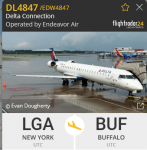kc2klc
Member
I haven't gotten my dedicated ADS-B antenna up yet, but am receiving signals out to 20+ miles with my roof-mounted discone 
I am observing a lot of discrepancies between what Virtual Radar (on Windows, using an RSP1A), FlightAware's online Live Flight Tracker, and the FlightRadar24 app on my iphone - with FlightAware appearing to be the most reliable. Twice this morning Virtual Radar told me I was receiving data from Delta commercial flights, but FlightAware disagreed. For example, I received data from a flight identified by Virtual Radar as a Delta flight from ATL to PBI, which is clearly wrong (departure and arrival are in Florida; I'm in upstate NY) - FlightAware correctly identified it as an Endeavor Air flight from LGA to YYZ (and FlightRadar24 showed nothing).
I guess these different apps use different databases? Is there a way for me to improve Virtual Radar's identifications? Thanks!
I am observing a lot of discrepancies between what Virtual Radar (on Windows, using an RSP1A), FlightAware's online Live Flight Tracker, and the FlightRadar24 app on my iphone - with FlightAware appearing to be the most reliable. Twice this morning Virtual Radar told me I was receiving data from Delta commercial flights, but FlightAware disagreed. For example, I received data from a flight identified by Virtual Radar as a Delta flight from ATL to PBI, which is clearly wrong (departure and arrival are in Florida; I'm in upstate NY) - FlightAware correctly identified it as an Endeavor Air flight from LGA to YYZ (and FlightRadar24 showed nothing).
I guess these different apps use different databases? Is there a way for me to improve Virtual Radar's identifications? Thanks!


